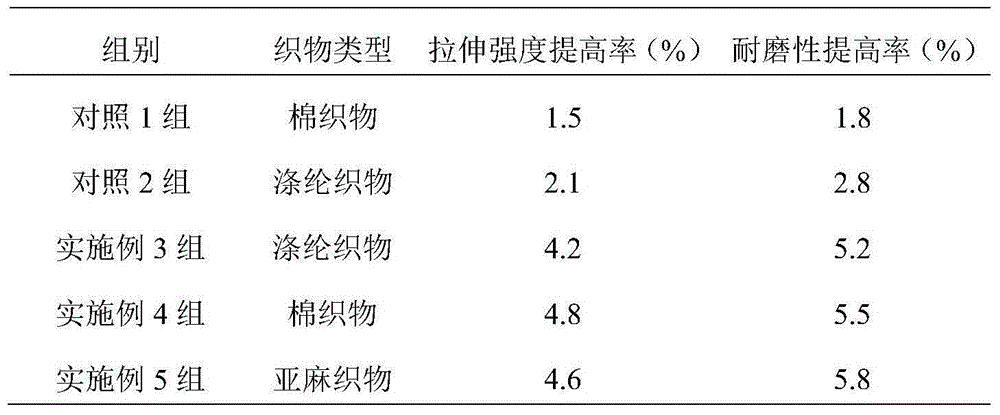Printing and dyeing finishing agent for fabric
A finishing agent and fabric technology, used in fiber treatment, textile and papermaking, biochemical fiber treatment, etc., can solve the problems of poor wear resistance and stretch resistance, the fabric can not meet the production needs, and the application range is small, etc. problem, to achieve the effect of low cost, excellent performance and wide application range
- Summary
- Abstract
- Description
- Claims
- Application Information
AI Technical Summary
Problems solved by technology
Method used
Image
Examples
Embodiment 1
[0022] Party:
[0023] 40 parts of ricinoleic acid butyl sulfate, 20 parts of polyethylene glycol laurate, 1 part of sodium sulfate, 10 parts of coconut oil diethanolamide, 2 parts of aluminum oxide, 5 parts of glyceraldehyde 3-phosphate dehydrogenase 1 part of palmitic acid, 2 parts of sodium oleate, 1 part of titanium dioxide, 4 parts of p-hydroxyphenylacetyl chloride, 800.1 parts of Tween, 0.2 parts of glyceryl monostearate, 100 parts of pure water, and 70 parts of glycerin.
[0024] Preparation:
[0025] (1) Get sodium sulfate, coconut oil diethanolamide, 3-phosphoglyceraldehyde dehydrogenase, palmitic acid and sodium oleate, join in pure water, make aqueous solution;
[0026] (2) Sulphate ester of butyl ricinoleate, polyethylene glycol laurate, aluminum oxide, titanium dioxide and p-hydroxyphenylacetyl chloride are added to glycerin, and a glycerin solution is made at 40° C.;
[0027] (3) Mix the above aqueous solution and glycerin solution, add Tween 80 and glyceryl mo...
Embodiment 2
[0029] Party:
[0030] 40 parts of ricinoleic acid butyl sulfate, 40 parts of polyethylene glycol laurate, 9 parts of sodium sulfate, 30 parts of coconut oil diethanolamide, 8 parts of aluminum oxide, 15 parts of glyceraldehyde-3-phosphate dehydrogenase 7 parts of palmitic acid, 2-10 parts of sodium oleate, 5 parts of titanium dioxide, 16 parts of p-hydroxyphenylacetyl chloride, 800.7 parts of Tween, 0.6 parts of glyceryl monostearate, 200 parts of pure water, and 90 parts of glycerin.
[0031] Preparation:
[0032] (1) Get sodium sulfate, coconut oil diethanolamide, 3-phosphoglyceraldehyde dehydrogenase, palmitic acid and sodium oleate, join in pure water, make aqueous solution;
[0033] (2) Sulphate ester of butyl ricinoleate, polyethylene glycol laurate, aluminum oxide, titanium dioxide and p-hydroxyphenylacetyl chloride are added to glycerin, and a glycerin solution is made at 60° C.;
[0034] (3) Mix the above aqueous solution and glycerin solution, add Tween 80 and gly...
Embodiment 3
[0036] Party:
[0037] 40 parts of ricinoleic acid butyl sulfate, 30 parts of polyethylene glycol laurate, 5 parts of sodium sulfate, 20 parts of coconut oil diethanolamide, 5 parts of aluminum oxide, 10 parts of glyceraldehyde 3-phosphate dehydrogenase 4 parts of palmitic acid, 6 parts of sodium oleate, 3 parts of titanium dioxide, 10 parts of p-hydroxyphenylacetyl chloride, 800.4 parts of Tween, 0.4 parts of glyceryl monostearate, 150 parts of pure water, and 80 parts of glycerin.
[0038] Preparation:
[0039] (1) Get sodium sulfate, coconut oil diethanolamide, 3-phosphoglyceraldehyde dehydrogenase, palmitic acid and sodium oleate, join in pure water, make aqueous solution;
[0040] (2) Sulphate ester of butyl ricinoleate, polyethylene glycol laurate, aluminum oxide, titanium dioxide and p-hydroxyphenylacetyl chloride are added to glycerin, and glycerin solution is made at 50° C.;
[0041] (3) Mix the above aqueous solution and glycerin solution, add Tween 80 and glyceryl...
PUM
 Login to View More
Login to View More Abstract
Description
Claims
Application Information
 Login to View More
Login to View More - R&D
- Intellectual Property
- Life Sciences
- Materials
- Tech Scout
- Unparalleled Data Quality
- Higher Quality Content
- 60% Fewer Hallucinations
Browse by: Latest US Patents, China's latest patents, Technical Efficacy Thesaurus, Application Domain, Technology Topic, Popular Technical Reports.
© 2025 PatSnap. All rights reserved.Legal|Privacy policy|Modern Slavery Act Transparency Statement|Sitemap|About US| Contact US: help@patsnap.com

